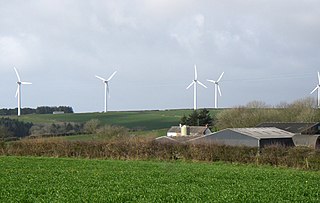Related Research Articles

Geothermal energy is the thermal energy in the Earth's crust which originates from the formation of the planet and from radioactive decay of materials. The high temperature and pressure in Earth's interior cause some rock to melt and solid mantle to behave plastically. This results in parts of the mantle convecting upward since it is lighter than the surrounding rock. Temperatures at the core–mantle boundary can reach over 4000 °C (7200 °F).

The Weardale Railway is an independently-owned British single-track branch line heritage railway between Bishop Auckland, Witton-le-Wear, Wolsingham, Frosterley and Stanhope. Weardale Railway began services on 23 May 2010, but decided to run special trains rather than a scheduled service for the 2013 season. The line was purchased by the Auckland Project in 2020 with a view to restarting passenger services. In 2021, a bid was submitted to the Restoring Your Railways fund. In October 2021, the Department for Transport allocated funding for the development of a business case.
Eastgate is a village in County Durham, England. It is situated in Weardale, a few miles west of Stanhope. In the 2001 census Eastgate had a population of 163.

Thornley is a village in County Durham, in England. It is situated about 5 miles (9 km) to the east of Durham and 5 miles (7 km) west of Peterlee. Thornley is part of the Sedgefield parliamentary constituency of which Tony Blair was the Member of Parliament from 1983 until 2007.

Bishop Auckland is a railway station that serves the market town of Bishop Auckland in County Durham, North East England, 11 miles 77 chains (19.3 km) north-west of Darlington. The station is the Western terminus of the Tees Valley Line, which links it to Saltburn via Darlington. It is owned by Network Rail and managed by Northern Trains.

A ground source heat pump is a heating/cooling system for buildings that uses a type of heat pump to transfer heat to or from the ground, taking advantage of the relative constancy of temperatures of the earth through the seasons. Ground source heat pumps (GSHPs) – or geothermal heat pumps (GHP) as they are commonly termed in North America – are among the most energy-efficient technologies for providing HVAC and water heating, using far less energy than can be achieved by burning a fuel in a boiler/furnace or by use of resistive electric heaters.


The potential for exploiting geothermal energy in the United Kingdom on a commercial basis was initially examined by the Department of Energy in the wake of the 1973 oil crisis. Several regions of the country were identified, but interest in developing them was lost as petroleum prices fell. Although the UK is not actively volcanic, a large heat resource is potentially available via shallow geothermal ground source heat pumps, shallow aquifers and deep saline aquifers in the mesozoic basins of the UK. Geothermal energy is plentiful beneath the UK, although it is not readily accessible currently except in specific locations.

Renewable energy in the United Kingdom contributes to production for electricity, heat, and transport.

Geothermal power is electrical power generated from geothermal energy. Technologies in use include dry steam power stations, flash steam power stations and binary cycle power stations. Geothermal electricity generation is currently used in 26 countries, while geothermal heating is in use in 70 countries.

Engie SA is a French multinational utility company, with its headquarters in La Défense, Courbevoie, which operates in the fields of electricity generation and distribution, natural gas, nuclear, renewable energy and petroleum. It is active in both upstream and downstream activities.
West Indies Power was a geothermal power company registered in 2001 in the Netherlands Antilles and with the head office in Charlestown, Saint Kitts and Nevis. It conducted studies on geothermal power projects in Nevis, Saba and Dominica.
United Downs Deep Geothermal Power is the first geothermal electricity project in the UK. It is the natural progression of the Camborne School of Mines led Cornish Hot Dry Rocks (HDR) project, undertaken in the 1980s at Rosemanowes Quarry, designed to test and prove the theory of inducing a fracture network within the heat-producing granite to create a geothermal reservoir. Situated near Redruth in Cornwall, England, the project has now proven that harnessing geothermal energy is possible in the UK, encountering temperatures and fluid flow rates that are capable of driving a steam turbine to generate electricity. The project has also unexpectedly enabled the extraction of Lithium.

The North Pennine Batholith, also known as the Weardale Granite is a granitic batholith lying under northeast England, emplaced around 400 million years ago in the early Devonian. The batholith consists of five plutons, the Tynehead, Scordale, Rowlands Gill, Cornsay and Weardale plutons. The Weardale Granite pluton is the largest and the only one that has been proved (sampled), after the Rookhope Borehole confirmed Martin Bott's hypothesis that a large negative gravity anomaly under Weardale represented a low-density igneous intrusion.

Most of Kenya's electricity is generated by renewable energy sources. Access to reliable, affordable, and sustainable energy is one of the 17 main goals of the United Nations’ Sustainable Development Goals. Development of the energy sector is also critical to help Kenya achieve the goals in Kenya Vision 2030 to become a newly industrializing, middle-income country. With an installed power capacity of 2,819 MW, Kenya currently generates 826 MW hydroelectric power, 828 geothermal power, 749 MW thermal power, 331 MW wind power, and the rest from solar and biomass sources. Kenya is the largest geothermal energy producer in Africa and also has the largest wind farm on the continent. In March 2011, Kenya opened Africa's first carbon exchange to promote investments in renewable energy projects. Kenya has also been selected as a pilot country under the Scaling-Up Renewable Energy Programmes in Low Income Countries Programme to increase deployment of renewable energy solutions in low-income countries. Despite significant strides in renewable energy development, about a quarter of the Kenyan population still lacks access to electricity, necessitating policy changes to diversify the energy generation mix and promote public-private partnerships for financing renewable energy projects.

Renewable energy in Armenia ranges from geothermal, hydroelectric, solar and wind energy in Armenia.
The Karkar Geothermal Power Plant (Karkar GTPP) (Armenian: Կարկառի երկրաջերմաէլեկտրակայան) is a proposed geothermal power plant to be constructed in Armenia. The plant will be the first of its kind in Armenia and will be situated at the Karkar site in the southernmost province of Armenia, Syunik. Initial studies envisage the construction of a 28-30 MW capacity geothermal power plant with an annual electric output of 250 million kilowatt hours (kWh) according to data provided in 2016. The Karkar GTPP will allow for the production of heat to be used in the heating of greenhouses, residential buildings, and industrial sites. Commissioned in 2008-2009, the Karkar GTPP is a unique project in Armenia in that it does not possess an analogue in the region, and positively differs from other energy producing power plants in its renewability of resources, independence from imported energy sources, as well as its minimal environmental impact.

Eastgate railway station, also known as Eastgate-in-Weardale, served the village of Eastgate in County Durham, North East England from 1895 to 1953 as a stop on the Wear Valley Line.

Harperley railway station served the Harperley Hall Estate and the nearby hamlet of Low Harperley, close to the village of Fir Tree in County Durham, North East England between 1861 and 1864 and again from 1892 to 1953 as a stop on the Wear Valley Line.

Witton-le-Wear railway station is a railway station on the Weardale heritage railway serves the village of Witton-le-Wear in County Durham, North East England, and is the penultimate stop for most of line's eastbound passenger services. The current station platform is located on the opposite side of the track to the original railway station which was operation between 1847 and 1953.
References
- ↑ "Eco project gets unanimous approval (From The Northern Echo)". Thenorthernecho.co.uk. 2009-09-29. Retrieved 2012-11-21.
- ↑ Amy Hunt (2009-09-30). "News - Environment - Plans for Eastgate eco village approved". JournalLive. Retrieved 2012-11-21.
- 1 2 "Eastgate Renewable Energy Village". www.davidlock.com. Archived from the original on 7 June 2007. Retrieved 17 January 2022.
- ↑ "Eastgate Geothermal Borehole Interim Report" (PDF). Wearvalley.gov.uk. December 2004. Archived from the original (PDF) on 2011-07-18. Retrieved 2012-11-21.
- ↑ "A deep geothermal exploration well at Eastgate, Weardale, UK: a novel exploration concept for low-enthalpy resources". Jgs.lyellcollection.org. Retrieved 2012-11-21.
- ↑ Amy Hunt (September 30, 2009). "Plans for Eastgate eco village approved". Journallive.co.uk. Retrieved 2012-11-21.
- ↑ "Budget cuts leave future of eco-village uncertain (From The Northern Echo)". Thenorthernecho.co.uk. 2010-09-25. Retrieved 2012-11-21.